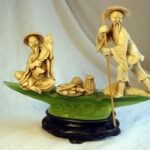The “darkness” depicted clearly refers to the “darkest” side of human nature as seen in the brutal colonists and ivory traders illustrated in Heart of Darkness. Now, to articulate this thought more clearly, one must evaluate a few occurrences of the term “darkness” in the work.
Some examples of these events include references to Kurtz (“[t]he thing was to know how many powers of darkness claimed him for their own”) on page 1926, or on page 1941 (“[h]is was an impenetrable darkness.”); one also see “darkness” in other senses too. This is the case as witnessed during the voyage up the Congo River on page 1915 (“[w]e penetrated deeper into the heart of darkness”), and the final sentence of this work, appearing on page 1947 “[t]he offing was barred by a black bank of clouds, and the tranquil waterway leading into the uttermost ends of the earth flowed sombre under an overcast sky—seemed to lead into the heart of an immense darkness.” It is important to make one thing perfectly clear here: it appears as though Kurtz himself is not THE “heart of darkness” of the entire ivory trade in all of Africa. While portrayed as a particularly powerful man, Kurtz is only a symbolic figure of a much larger concept, and that is the brutality of the ivory trade as it existed in nineteenth-century Africa; the trade indeed was actively practiced by a number of European entities. Therefore, as one can realize, all of these references—be they to Kurtz, the despotic ivory trader himself; or to more abstract or, conversely, physical (even inanimate) aspects of the work—relate to one remaining common thread: allusions to human tyranny, injustice, and brutality.
Some of the symbols seen, such as the “darkness” that is “penetrated” during the voyage up the Congo River certainly refers to Marlow’s closing physical proximity to Kurtz and the ivory trade the trader helms (1915). Doubtlessly, the last sentence of the work, referring to the “tranquil waterway” shrouded by mist and shadowed under “black clouds” that seem “to lead into the heart of an immense darkness” also evokes something greater than a description of the physical environement. This scene, depicting a broad scope of land, sea, and sky, symbolizes just how pervasive and widespread the “darkness” of the human “heart” can be. Indeed, this suggestion is that “darkness” is not confined to but a few individuals but, theoretically, there is a “dark” side that can be realized by potentially most anyone. “Hearts of darkness” (plural) are not found only beating in the chests of the wicked ivory traders in Africa, but any and all who condone the activities of those brutal ivory traders—including the consumers who, while perhaps or perhaps not aware of the brutality of the ivory traders, still purchase the goods that are the byproduct of the tyrannical and inhumane ivory traders of the most severe persuasion, which includes those of the likes of Kurtz. Yet, as seen both in the Kurtz’s eventual death and those subject to his terrible power, the “darkness” of the heart can be a most delerterious force indeed.
The bottom line is that, as evidenced by the symbolic and actual correlations to Kurtz, the ivory trade, and the inhumane philosophies employed in much of the illustrated ivory trade, one can begin to grasp a larger idea, and that is the concept that a “heart of darkness” can exist in anyone. What makes the idea of a “heart of darkness” even more so concerning to the human race is that many people whose “hearts” participate in “dark” activities or lifestyles do not even realize they are doing so. Why, many may hardly even have to try. While some ivory consumers were aware of the brutal practices used in obtaining ivory, many consumers saw only the allure of a sought-after commodity, all the while unaware of the abhorrent conditions of the African laborers. Some employees in the ivory companies sought only slightly better wages—not tyranny and supremacy over other people. Marlow, when in the book he once expresses awe over the incredible hold Kurtz has upon the ivory trade, seems to temporarily shrug aside the underlying “darkness” of Kurtz.
In these ways then, one can begin to understand that the “heart of darkness” to which Conrad refers in the title of his acclaimed work clearly relates to the very real concept of tyranny, inhumanity, and the purveying of severe injustice to others. Further still, though, this “heart of darkness,” as seen in those other than Kurtz, is an often quiet bane which can potentially dwell deep within even the most seemingly benign of people. Therefore, one must recognize the real threat of the awful potential of this human “darkness” before succumbing to its clutches and destroying not just others but, also, as seen through Kurtz, oneself.
Work Cited:
Conrad, Joseph. Heart of Darkness.” The Norton Anthology: English Literature. General Ed. Stephen Greenblatt. 8th Ed. New York: Norton, 2006. 1891-1947.


